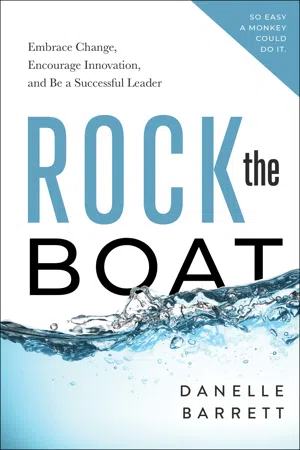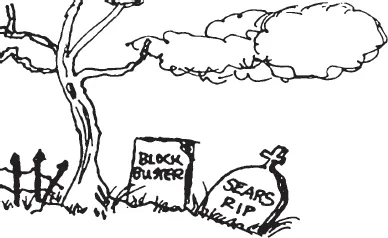![]()
ONE
LEAD CHANGE
We live in an age in which exponentially accelerating and converging technology is fundamentally altering the way we live. The current rate of change can seem daunting and challenging, but it presents opportunities and risks that leaders should seek out and take advantage of. Whereas some people experience a tsunami of uncertainty that can bring discomfort and stress, others thrive on the newness and sense of possibility. Your workforce will be a combination of the two extremes and the middle ground, but they all will look to your leadership for guidance and direction.
Change is exciting but also makes people uncomfortable, as it disrupts the status quo and often flies in the face of conventional wisdom, existing processes, and norms that people have grown used to or built careers around. They can resist change and be blind to the opportunities that come with it. The inability to see the effect a technology can have on business and operational processes has been the demise of many formerly successful companies.
For example, Blockbuster was once the world leader in home video rental. Every home had a VCR, and so instead of packing up the family for a night out at a movie theater, we might rent a half-dozen tapes for the weekend. The home television became the new cinema. When the internet came along, Blockbuster’s vision remained in the rearview mirror, and the company missed the boat. Netflix pushed Blockbuster out of the video rental market by allowing customers to find movies from home and have DVDs shipped directly to them. But then Netflix went further, embracing online streaming video and fundamentally transforming how we consume entertainment.
Sears, once the largest retailer in the United States, similarly brought about a sea change and then drowned under the next wave. When Sears began, the home goods industry was stationary. You had to visit a physical store, and your choices were limited to whatever it had in stock. These stores also most likely sold only a single category of items, so, for instance, if you needed both some new bedding and a cooking pot, you’d have to go to two different stores. Then Sears took a risk; it spent a huge sum on print and mailing services instead of on local advertising budgets and sales events. Sears put a catalog in every mailbox, full of every kind of merchandise you could imagine—housewares, appliances, toys, clothing—and the company sailed ahead of its competition and changed the way people shopped. Just a few decades later, catalogs disappeared as online shopping took their place. Sears was left with hundreds of physical stores that no one was visiting, and Amazon ate their lunch. Not only did we no longer have to step into a store, but we also didn’t have to wait for a new catalog each month. We could browse for anything we could want from the comfort of our couches and have it delivered directly to our door. The inability of Sears to question its culture and the future relevance of its existing business and to see the opportunity of the convergence of technologies like the internet, big data, and logistics transformation led to its downfall. Timing is everything. When Sears did realize what it needed to do, it was too late to take on the successful behemoths like Amazon.
OPPORTUNITY AND RISK
As you can see, change poses both opportunity and risks to an organization, and how you and your team respond will determine your future. Embracing opportunity—identifying the art of the possible—and being able to combine people, processes, and technology will substantially improve an organization’s outcomes. Of course, you may adopt the wrong technology or apply it too quickly without addressing the implications of implementation. Paving the cowpath is also a real danger—that is, using the new technology without the benefit of changing processes and fully embracing the change. The biggest risk may lie in not adopting a technology that could be transformational for your organization and that others will use to gain a competitive advantage. Identifying those converging technologies that are truly transformational is the real game changer, and you need your team trained to think that way.
Ask yourself, Do I want to be Amazon or Sears? Are we going to be Blockbuster or Netflix? Being agile means understanding the risk of adopting or not adopting a potentially transformational technology and being able to pivot with the change if need be. You need to plan for the elements of change that accompany a technology’s insertion that could lead to success. You need to be comfortable with being uncomfortable. Being a change agent means bringing others along with you. You are the Pied Piper, with a vision for what the future looks like that people can understand, rally behind, and see themselves being a part of.
Vision
Think about recent advances and how they have significantly affected our daily lives. If you had a flip phone fifteen years ago, you were the cool kid, and you might have even received a text message or two. Today, we use our smartphones as sources of limitless information and constant connection and distraction in our pocket. A technology that was, at one point, full of possibilities and challenges now permeates everything.
To successfully keep a business afloat—let alone mentoring others for the future—you need to be attuned to incoming trends and innovation. You must be able to see not just how technology can provide a competitive advantage for your organization now, but how it could change the very nature of leadership, collaboration, information sharing, and how we communicate. True innovations change everything, and only those ready to embrace change can get ahead of the wave.
Vision distinguishes good leaders from great leaders and wildly successful organizations from mediocre ones. When considering technology changes, visionary leaders understand that processes and people must be combined with the technology to make it work. Understanding the possible implications of exponentially accelerating and converging technology can give you a considerable competitive advantage, but you need to integrate this technology and its accompanying process change into your business. You need to be proactive in thinking about how to use it, identifying how it might provide an advantage, and implementing it at speed.
Promote the wild imagination
Ten years ago, no one had heard of Uber, unless you were German and everything was “Uber fantastisch”! Today, not only have most people heard of ride-share services like Uber and Lyft, but those companies have become a part of our daily lives, particularly if you reside in a densely populated area. Forget that old advice from Mom about not getting in the car with strangers. Throw caution to the wind, friends. Ride-shares were able to upset the transportation industry because they are cheaper, faster, and more convenient than the alternatives. Instead of calling a taxi the night before or waiting around for a bus, we can simply tap the Uber app on our smartphone and have a ride to the airport in minutes.
Now, imagine that you combined Uber with an electric, autonomous, self-driving vehicle. That convergence of three powerful technologies would take change and its challenges and opportunities to a whole new level. We would no longer need to wait for a taxi or a bus, we wouldn’t have to stop for fuel as frequently (especially if it were solar), and we wouldn’t even need a driver. It would revolutionize the transportation industry and how we live.
Imagine a future world where those three technologies converge. This new mode of sustainable, convenient, and automated transportation means that kids born today would never need to learn how to drive a car. They would never own a car. It would mean that, unless the existing business models adapt, there would be no car dealerships, no rental companies, no car parts stores, and no car insurance industry. When I left for work in the morning, I would walk out of my house and a vehicle would be there waiting for me. It could be an autonomous vehicle that looks and acts like the cars we use today, or it could be some kind of hovercraft or pod. (That’s the point of letting your imagination go: You don’t have to be attached to what came before.) Based on the heuristics of my previous travel behavior, the vehicle would know what time I left every day and where I would be going. I would get in, the vehicle would scan the radio frequency ID in my arm or some other biometric authentication, it would charge my bank a small sum, and it would take me to work. If I needed to go to the airport instead, I would just tell it that and off we would go. Meanwhile, the vehicle would use artificial intelligence agents to scour the internet for information that would be helpful regarding my new destination, and it would provide that to me in the context that it knows would be most useful, presenting it both on a screen in the vehicle and to my smartphone or, eventually, directly to my brain.
Elements of this vision are already happening and much faster than we ever anticipated, so learn to look for the possibilities in a future like this and identify the risks of not adapting at speed (Sears). We already have unprecedented success in ride-sharing services. Self-driving cars and autonomous vehicles have made unprecedented advancements and are statistically safer than human drivers, and who knows what new use for them we’ll think of when they’re more widely available. The leaders in any industry will be those who can imagine what could be, then find a way to quickly make that possibility a reality. If you’re the one to successfully bring it to market, look out world!
The only obstacle to innovation and transformation is your imagination, so challenge yourself to see technology as an enabler of transformative ideas. This requires creative thinkers with the imagination to throw off the shackles of old ways of doing business to see a new future. Not everyone has that kind of vision, and if you don’t, you should surround yourself with people who do, and create a culture that rewards it. Don’t let them be self-limiting in their thinking or get discouraged by institutional inertia or resistance to change. Swiftly help them to remove cultural or institutional barriers for success and publicly reward those who get it right. Take off the blinders and run.
Be an innovator, inspire people to challenge the status quo, and communicate that vision with your teams of employees, stakeholders, and others you collaborate or operate with. This is what distinguishes great leaders from good managers. While there are many factors behind innovation, technology can be a major transformational driver when combined with the accompanying changes affecting people and processes. Lead technology-enabled change by looking for what could be with respect to your organization. Discover ways to not only address an existing challenge but also visualize the possibilities. Solve a problem that people don’t even realize they have yet.
IMAGINATION TO REALITY
To not only embrace change but lead it, you’ll need to inspire people and create processes to encourage innovation. First, you must move quickly. Technology—and any innovation—moves fast; if you drag your feet, you’ll be left behind. Next, you’ll need crystal-clear communication to get everyone on board—and keep them there. Finally, just as you embraced new ideas and new technology, you must encourage continued innovation in your team. Connect, collaborate, and act—then rinse and repeat.
Make it reality—quickly
You need to demonstrate capability quickly. No one wants to see you admire the problem and show your vision on PowerPoint slides indefinitely. They want to see it in action. They want to touch it, feel it, experience it.
Implement a strategic communication plan
You need to spread the word and get others to do the same using the same concepts and lexicon. This creates consistent messaging and makes the message for the vision clear to everyone involved, regardless of whether they are striving toward the same goal as everyone else. The plan applies to both internal and external communications. Keep your messaging consistent and simple, and tailored to your audience. Use marketing to discuss your change in operational terms that resonate with the audience, not technology geek-speak. Discuss the capability that will result and how operations could be improved with the application of these new technologies. Finally, call out those who get it right publicly. Let everyone know who is being creative and bold in adapting. The key is to make sure everyone understands what you are doing and why it matters.
Pet the cat
As with any comprehensive effort, there will be naysayers, those who remain staunchly opposed—you know, the type of people who spend more time and effort trying to say no when, if they just did it, they would be done already. They are the ones who often cast stones without providing a better solution.
Most often, they are fearful of the change because it upsets their apple cart or may be difficult to convey to their stakeholders and workforce. As a leader in this type of situation, you need to acknowledge that fear and help your team overcome it. I call this part “petting the cat.” Imagine a skittish cat on your lap. To keep it there, you need to pet it calmly and encourage it with a soothing “It’s going to be OK. Just stick with me here. Don’t jump off.” Help your people and key stakeholders see their path to alignment with the larger effort for success beyond just their organization.
Even then, you may still face opposition by those with their PhD in institutional resistance who will slow-roll you or be outright obstructionists. If a team member or key stakeholder can’t see how to reform their processes fast enough, has a myopic vision of the future or none at all, or is concerned about how the changes will affect them personally, they will be difficult to convince. The way forward is then to understand and acknowledge their angst, especially when they feel it may threaten their vision, resources, money, or people. Give them two shots to come aboard, spending time discussing how the changes could help their programs or capabilities and encouraging them to look beyond their organization to see the greater good. If they still resist, waste no more time with them and tell your team to do the same.
Instead, focus your time and energy on the 20 percent who get it immediately and the 60 percent who sit on the fence but can be pulled to your side. Focus on the positive forces and gather momentum and energy from them. Accept that you will lose that 20 percent who are resisting. Those anchors to progress will eventually be overcome by events when solutions become institutionalized across the enterprise. So, don’t waste time on them. They will be dragged along whether they support it or not, and your time is better spent moving forward.
Multitask
An organization-wide change requires leadership throughout the team to have many plates spinning at once. Focus on working towa...


